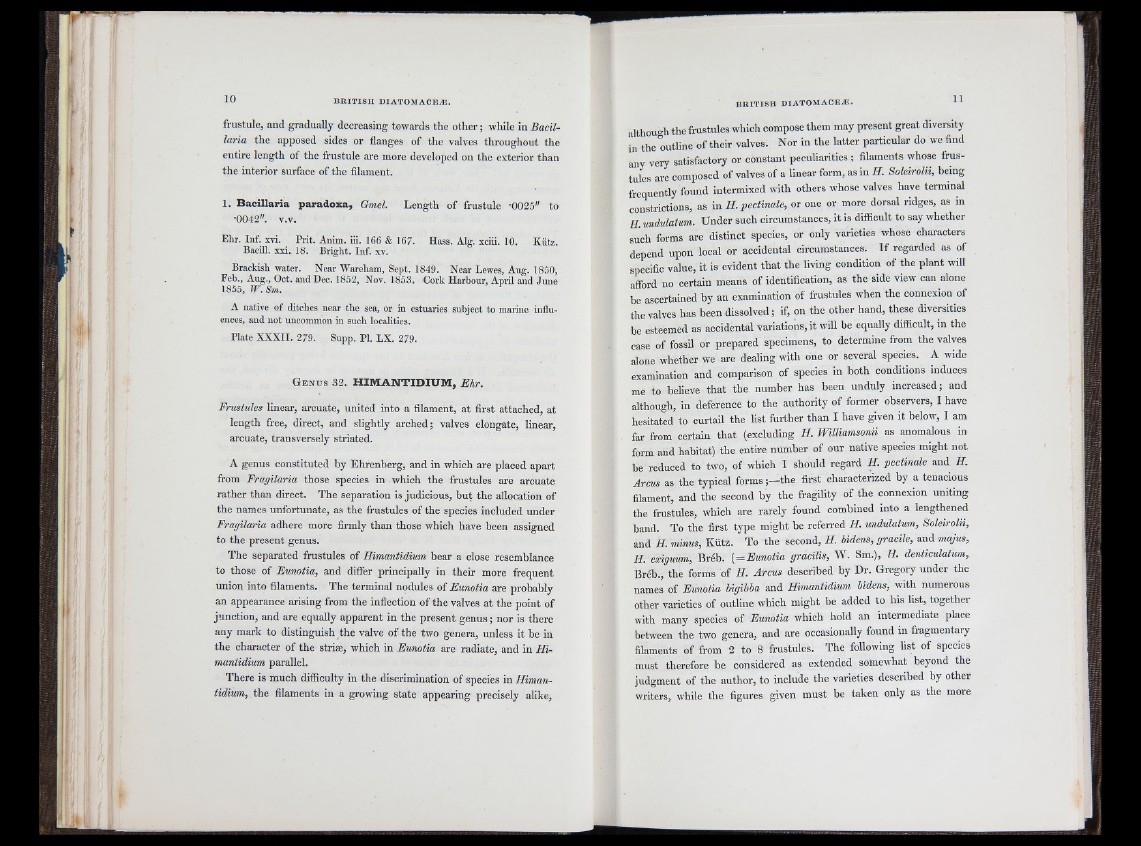
frustule, and gradually decreasing towards the o th e r; while in Bacil-
laria the apposed sides or flanges of the valves throughout the
entire length of the frustule are more developed on the exterior than
the interior surface of the filament.
1. B a ciUaria p a ra d o x a , Gmel. Length of frustule -0025" to
•0042". v.v.
Ehr. Inf. xvi. Prit. Anim. iii. 166 & 167. Hass. Alg. xciii. 10. Kiitz.
Bacill. xxi. 18. Bright. Inf. xv.
Brackish water. Near Wareham, Sept. 1849. Near Lewes, Aug. 1850,
Feb., Aug., Oct. and Dec. 1852, Nov. 1853. Cork Harbour, April and June
1855, ;r.*K.
A native of ditches near the sea, or in estuaries subject to marine influences,
and not uncommon in such localities.
Plate XXXII. 279. Supp. PI. LX. 279.
G en u s 32. H IM A N T ID IU M , Ehr.
Frustules linear, arcuate, united into a filament, at first attached, at
length free, direct, and slightly arched; valves elongate, linear,
arcuate, transversely striated.
A genus constituted by Ehrenberg, and in which are placed apart
from Fragilaria those species in which the frustules are arcuate
rather than direct. The separation is judicious, but the allocation of
the names unfortunate, as the frustules of the species included under
Fragilaria adhere more firmly than those which have been assigned
to the present genus.
The separated frustules of Himantidium bear a close resemblance
to those of Eunotia, and differ principally in their more frequent
union into filaments. The terminal nodules of Eunotia are probably
an appearance arising from the inflection of the valves at the point of
junction, and are equally apparent in the present genus ; nor is there
any mark to distinguish the valve of the two genera, unless it be in
the character of the striæ, which in Eunotia are radiate, and in Himantidium
parallel.
There is much difficulty in the discrimination of species in Himantidium,
the filaments in a growing state appearing precisely alike.
althouo-h the frustules which compose them may present great diversity
in th ew tlin e of their valves. Nor in the latter particular do we find
any very satisfactory or constant peculiarities ; filaments whose frustules
are composed of valves of a linear form, as in H. Soleirolii, being
frequently found intermixed with others whose valves have terminal
constrictions, as in H. pectinale, or one or more dorsal ridges, as in
H. undulatum. Under such circumstances, it is difficult to say whether
such forms are distinct species, or only varieties whose characters
depend upon local or accidental circumstances. I f regarded as of
specific value, it is evident th at the living condition of the plant will
afford no certain means of identification, as the side view can alone
be ascertained by an examination of frustules when the connexion of
the valves has been dissolved; if, on the other hand, these diversities
be esteemed as accidental variations, it will be equally difficult, in the
case of fossil or prepared specimens, to determine from the valves
alone whether we are dealing with one or several species. A wide
examination and comparison of species in both conditions induces
me to believe th at the number has been unduly increased; and
although, in deference to the authority of former observers, I have
hesitated to curtail the list further than I have given it below, I am
far from certain th at (excluding H. Williamsonii as anomalous in
form and habitat) the entire number of our native species might not
be reduced to two, of which I should regard H. pectinale and H.
Arcus as the typical f o r m s t h e first characterized by a tenacious
filament, and the second by the fragility of the connexion uniting
the frustules, which are rarely found combined into a lengthened
band. To the first type might be referred H. undulatum, Soleirolii,
and H. minus, Kütz. To the second, H. bidens, gracile, and majus,
H. exiguum, Breb. { -E u n o tia gracilis, W. Sm.), B. denticulatum,
Breb., the forms of H. Arcus described by Dr. Gregory under the
names of Eunotia bigibha and Himantidium bidens, with numerous
other varieties of outline which might be added to his list, together
with many species of Eunotia which hold an intermediate place
between the tw'o genera, and are occasionally found in fragmentary
filaments of from 2 to 8 frustules. The following list of species
must therefore be considered as extended somewhat beyond the
judgment of the author, to include the varieties described by other
writers, while the figures given must be taken only as the more